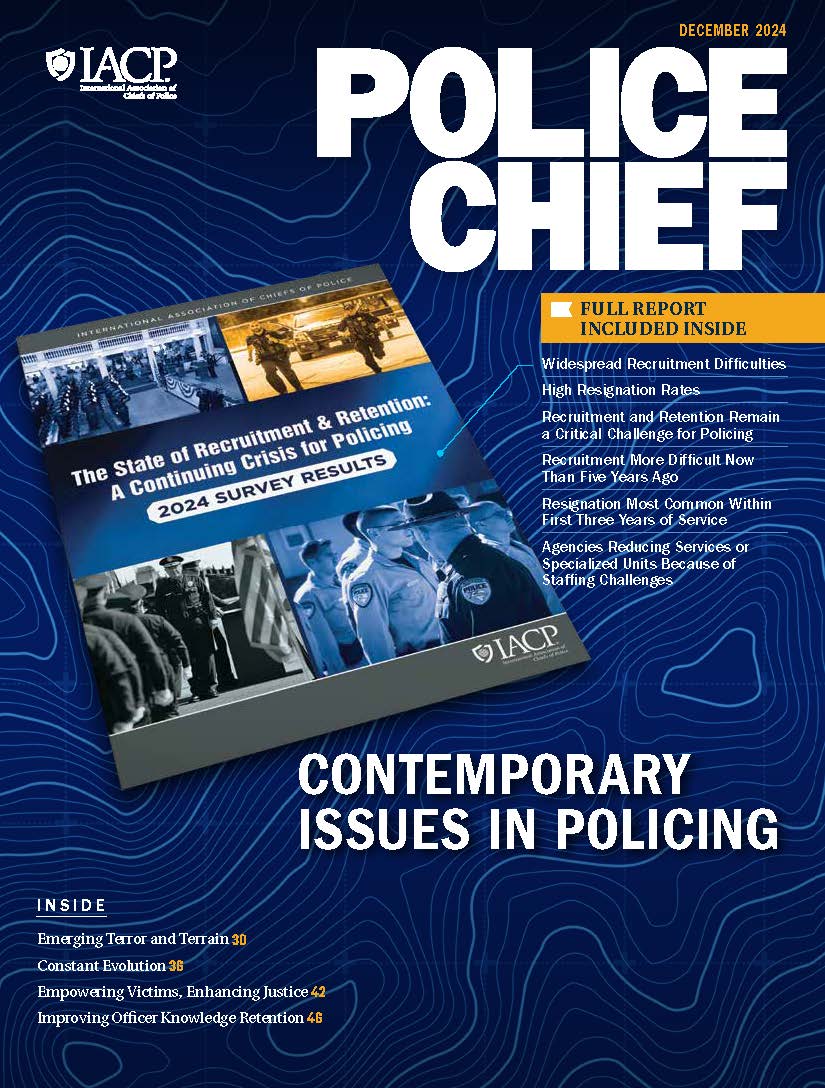When we hear about human trafficking, it is easy to think it is not happening in our communities and that federal law enforcement agencies handle those crimes. However, this most often is not the case.
The human trafficking epidemic is a global problem that can and does occur in almost every state and community. Like many of the challenges we face as law enforcement professionals, it is one that calls for a united effort and effective partnerships in order to be truly successful. This was recently demonstrated in June 2014, when the Federal Bureau of Investigation (FBI), working with state, local, and federal law enforcement partners, and the National Center for Missing and Exploited Children (NCMEC) successfully completed Operation Cross Country VIII with 54 FBI field divisions nationwide. The effort included enforcement actions in 106 cities with officers from more than 400 local, state, and federal law enforcement agencies and resulted in the recovery of 168 children who were being victimized through prostitution and the arrest of 281 pimps on state and federal charges.
In fact, since 2003, more than 3,400 children have been rescued in such operations, with 1,450 convictions of traffickers (including 14 life sentences), and more than $3.1 million in assets have been seized from those who traffic in children. As FBI Director James Comey recently stated, “These are not children living in some faraway place, far from everyday life. These are our children. On our streets. Our truck stops. Our motels. These are America’s children.”1
As law enforcement leaders, no matter where you are located or what size agency you lead, there are measures you can take to help combat and prevent human trafficking. Both education and collaboration are key elements to winning the fight against human trafficking. It is imperative that you educate the officers in your agency on human trafficking, both labor and sex trafficking, and how to recognize and respond to it. Your force also needs to be aware of how to investigate both the supply side (pimps and traffickers) and the demand side (buyers) of human trafficking. Both must be stopped in order to make a difference.
Community-wide education is also important. Inform your community members and local businesses, such as taxis or other transportation suppliers, hotels and motels, and schools and youth-serving groups how to report human trafficking. Your community is your eyes and ears and can help when it comes to investigation and enforcement.
Strength comes in numbers, so be sure to collaborate with local, regional, and state human trafficking task forces, as well as specialist units and coalitions. These partnerships should also include local partners that provide services for victims of human trafficking, such as advocates, medical practitioners, and faith-based organizations.
As law enforcement leaders, no matter where you are located or what size agency you lead, there are measures you can take to help combat and prevent human trafficking.
Be sure that you check out the several resources that are available to you and your agency to assist in this effort, including the following:
- The IACP law enforcement guide and roll call training video The Crime of Human Trafficking: A Law Enforcement Guide to Identification and Investigation (www.theiacp.org/portals/0/pdfs/CompleteHTGuide.pdf)
- The newly released VERA Institute of Justice Screening for Human Trafficking: Guidelines for Administering the Trafficking Victim Identification Tool (www.vera.org/sites/default/files/resources/downloads/human-trafficking-identification-tool-and-user-guidelines.pdf)
- The Department of Justice’s Office for Victims of Crime (OVC) and the Bureau of Justice Assistance (BJA), Anti-Human Trafficking Task Force Strategy and Operations E-Guide (www.ovcttac.gov/taskforceguide/eguide/Default.aspx)
In addition, at the 2014 Annual IACP Conference and Expo in Orlando, Florida, in October, the IACP and the Department of Justice’s Community Oriented Policing Services (COPS) Office, in partnership with the FBI, will be releasing a series of roll call training videos and tools targeted to front-line officers on how to recognize and respond to child sex trafficking.
It is my hope that you will find these resources beneficial as law enforcement professionals and will disseminate them among your colleagues. Together we can work to protect victims and stop the supply and demand of human trafficking. ♦
Note:
1James B. Comey, “Keeping America’s Children Safe” (Press Conference on Operation Cross Country VIII, Washington, D.C., June 23, 2014), http://www.fbi.gov/news/speeches/keeping-americas-children-safe (accessed July 18, 2014).
Please cite as:
Yousry “Yost” Zakhary, “Our Fight to Prevent Human Trafficking,” President’s Message, The Police Chief 81 (August 2014): 6.


